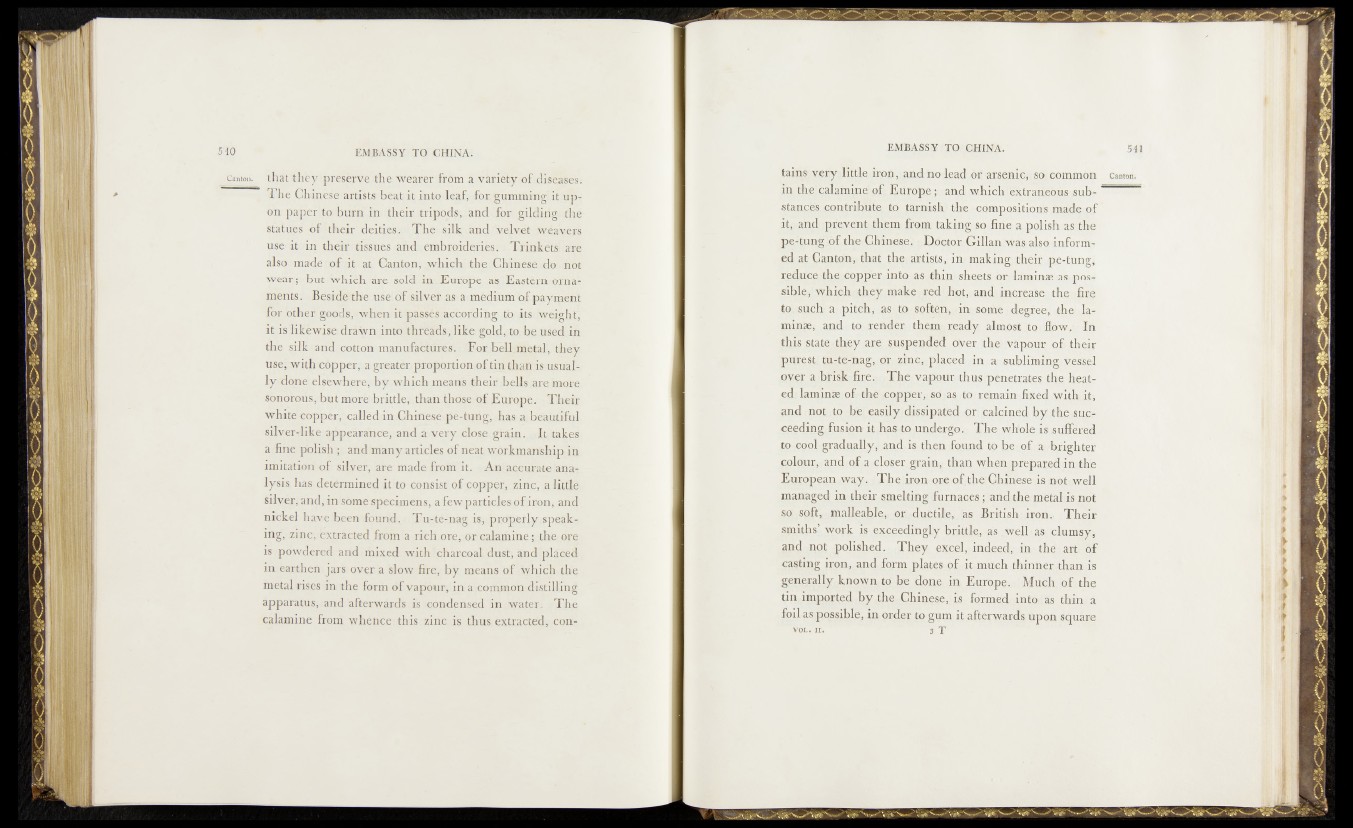
thjat they preserve the*Nearer from a variefty:of diseases*
The Changes artists be^tsit intode.afyjfor, gumnairighit.upon
paper LtaHib urn in their tripods, and for gilding the
statues o f ieheir ideitaegjpi T he s i lk . and ’‘velvet'dWeaWe.rs
in their f tissues and embroideries. -; Trinkefska^e
also made o f it at €!an£on, .which the Chinese »do not
wear; but Which are sold in Europe as Eastern ornaments.
Beside the use o f silver as a medium o f payment
for otheif goods,vwhen it passes^according ,tp its, {weight;
it is likewise drawn into threads, Iike:goU,£o/bgfugedpin
the silk arich cotton manufactures. For beJhn&etaJr, tlhhy
use,rwith cbpperjijB,greater.»proportion of tin thanismsual-
ly 'doneM|ew*here^by^ which means thebijbel.ls tare more,
sonorous,*but more brittle, than thqseaf.Europe. - Their
whitdcopper, called in Chinese'pe-tiihg, has aj beautiful
silver Tike appearance, and a very close .giain., IptakgS;
affine polish; and many articles, bf neat Workmanship in
imitation o f silver, are made from ^it.{ An; accurateh-nay
lysis, has determined it to consist o f copper, zinc, a little
silver, and, in some specimensf a fewparticles ofiron, and
nickel h ave'been found. Tu-te-nag is, prdperly speaking,
zincy extracted from a rich ore, or calamine ;jfche»ore
is powdered, and mixed with charcoal dust, and placed ;
in earthen jars tiver a slow fire, b y means of which the
metal rises in the form of vapour, in a common distilling
apparatus, and afterwards is condensed in water. The
calamine from whence this zinc is thus extracted, conta
ii^ YAeriyoM$tkdr^ ,..and noTsadrbr'ars£nic,^d& common canto»,
in ih^lh^l^inin^rft E4r<% c ; :and|,which ^extratiebiis ,sub-
sta^fegfe^ftr^trilfila hi jtar.nisht tjbe, 3 compositions made-:of
it, and prevent them from taking .so (fine anplisbus the
pe-ltuB^lof the» Ch in f e ^Ddgtor. GillaipW|^t®fcftimforiii-
ed at- (^'tbn>> that t h e g ^ i ^ i in, making their ipe-tung,
jh teee the.cpppfeMjto;as fh-in shmfe^ar^laminae-asjfos-
sihksl which thejiijnaatkp, red1 mptand f f f i^ ake the >fht,e
to, such a pitch, as\%yspften, i®«sorne - laming,
and to, reader,, them, ready algp^lQto fiow. In
thi|S .statejA-fey^are; sp.spenped ^ e c thefivalpour of; their
ppjgst, tu:teLp.ag§ffe?jneyIplacedv in a subliming^sisel
oyer a.bfish firjem The y a jp o p e th u slp en g ^ e sy ^ ilm^
ed; laminae of -the-^opper, {tp,- remain-,;fixed with it;
and fhot1jt#ie|Vasdcyidp^®M^i.P.rlJga|oiEied)
ee^edipgyfusion- it sba§ to jundeijgp^. Th©j whole is s offered
tOiCopl gradualtyy and, is thenjfe^ipd tp be ref ya,brighter '
ggiptury andLq f|a ^ l^ e r1>g ^ 40i,: than whcn^piPepared in the
European way.. Theprop orJo*of»tpgQhiEfese3ls notprell
managed' in their smelting furnaces: ia-ndithe metahis not
so soft, malleal)ley oC ducti$e,'yes British.iron., Their
smiths, work is exceedingly brittle, as .wellyas».clumsy;
and pot; polished. ^They excel,.indeed, in the. art! o f
casting iron, and form plates.M p t much j|pnner,than is
generally known to be done in, Europe. Miich o f the
tin imported b y the, Chinese,; is. formed into .as thin a
foil as possible, in order to gum it afterwards hpon square
v6t.,ri. ' ' j P '